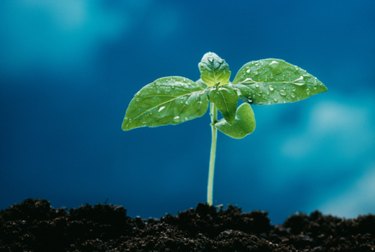
Only a complete set of favorable environmental conditions will cause the embryo in a seed to begin growing. Sprouting at the wrong time or in the wrong place means certain death for the seedling. The seeds of some plants germinate only when triggered by specific light levels. Ambient light intensity changes with a seed's depth beneath the soil and the degree of shade. Large photo-dormant seeds requiring deep burial in soil sprout only in darkness, while tiny photo-dormant seeds unable to emerge through deep soil sprout only in direct light on the ground's surface. Photo-dormant seeds of some forest trees stay dormant in deep shade, but when a tree falls and opens up a sunny clearing, photo-dormant seeds triggered by the sunshine sprout.
Germination Triggers
Video of the Day
Until seeds encounter specific sets of germination triggers, they remain dormant. For many agriculturally important plants, germination depends on moisture, temperature, oxygen and light. Without sufficient moisture in the upper soil layers, seeds wither before roots drill to moist depths. Sprouting in cold soil might expose the emerging seedling to fatal frosts. Plant roots breathe oxygen and suffocate in wet, dense anaerobic soil. Photo-dormant plants use degrees of light or darkness to determine the best time and location for growth. Tiny tobacco seeds, for example, don't sprout in darkness, so growers spread them on the surface of moist seed flats under controlled lighting.
Video of the Day
Timing
Survival chances for seedlings improve when the seed lands in new territory. Some seeds depend on airfoils or fluff for dispersal on the wind, while others enter a prolonged dormancy. Natural forces and the actions of birds, animals and insects scatter the dormant seeds. After-ripening, or aging at room temperature for a few months, might enable germination in some seeds, but others require stratification. Many plants native to temperate zones depend on seasonal temperature changes to set the stage for growth. Seeds of these plants won't sprout unless exposed to long periods of winter cold.
Temperature and Moisture
Spring or fall will provide some of the best growing conditions for young plants. Annuals sprout in spring when exposed to the correct combination of light, temperature and moisture. Biennial plants that live for two seasons often sprout in spring or fall. Spring emergence could produce a short-lived plant that flowers and dies the first year. Biennials germinating later in the year put energy into strong roots and die back to the root crown for the winter; they flower the next spring. Some plants produce seed with hard, waterproof seed coats that prevent germination until external forces crack the shell. Fires that destroy established plants also crack the seeds of the next generation and trigger new growth.
Special Factors
Some plants germinate only when special circumstances, such as flooding, decimate the existing plants in the area. Damp soil and rotting vegetation release ethylene gases that trigger these dormant seeds to start growing. Other plants measure favorable conditions by the presence of certain fungi and germinate in response to gibberellic acids these fungi produce. Plants that favor burned areas often germinate in response to smoke as well as heat. If exposed to the nitrous dioxide in smoke, the seeds of the yellow whispering bells plant begin germination less than a minute later, according to researchers at Occidental College in Los Angeles.
- University of Kentucky; Seed Dormancy in Commercial Vegetable and Flower Species; Robert L. Geneve
- Virginia Cooperative Extension; Plant Propagation from Seed; Diane Relf; May 2009
- The Seed Biology Place; Seed After-Ripening: Dormancy Release and Promotion of Germination; November, 2009
- Iowa State Weed Science; Air Pollution and Seed Germination; Bob Hartzler; 1997
- Ohio State University Extension; Factors Affecting Seed Germination; Mark A. Bennett
- The Seed Biology Place: Seed Germination